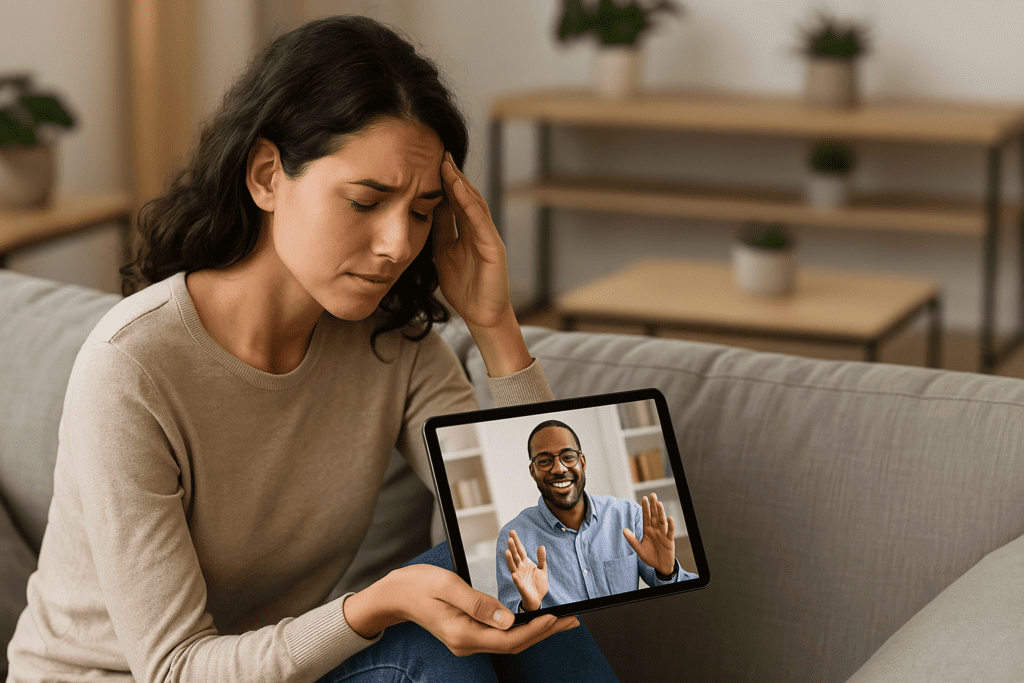In today’s digital age, the intersection of technology and mental health care has opened new pathways for accessible and effective psychological treatment. Among these advancements, videos on cognitive behavioral therapy (CBT) have emerged as powerful tools for both clinicians and individuals seeking support. As the stigma surrounding mental health continues to decrease and demand for evidence-based treatment rises, the use of CBT video resources is gaining momentum. These videos not only offer structured therapeutic guidance but also bring the expertise of trained professionals directly into homes, schools, and workplaces. For those navigating the complexities of anxiety, depression, stress, and other mental health conditions, CBT video platforms provide a flexible, engaging, and scientifically validated alternative to traditional in-person therapy.
You may also like: How Does CBT Work to Improve Relationships and Communication? Science-Backed Techniques for Getting Along with Others
Cognitive behavioral therapy is widely recognized for its structured, solution-focused approach, targeting negative thought patterns and maladaptive behaviors. What sets CBT apart is its empirical foundation—decades of research support its effectiveness in treating a wide range of psychological disorders. However, the accessibility and scalability of CBT have historically been limited by geographic, financial, and systemic barriers. The emergence of CBT video content is transforming this landscape by expanding access to high-quality therapeutic interventions, often at a fraction of the cost and time required for traditional sessions. These video resources range from therapist-led sessions to animated educational series, all designed to replicate core CBT techniques in an engaging and digestible format.
The effectiveness of videos on cognitive behavioral therapy lies in their ability to visually demonstrate techniques that might otherwise be difficult to grasp through text or static resources. For example, a CBT video may guide viewers through cognitive restructuring, illustrating how to identify and challenge automatic negative thoughts. Other videos may model behavioral activation strategies, such as scheduling pleasurable activities or practicing exposure to feared situations. These visual demonstrations help reinforce learning and make abstract concepts more tangible, which can be particularly helpful for individuals with learning differences or those who benefit from multimodal instruction. Moreover, seeing a therapist explain a concept with empathy and clarity can increase a sense of trust and connection, even in digital formats.
In addition to enhancing understanding, CBT video content supports repeated exposure and self-paced learning. Unlike in-person therapy sessions that may occur once a week, videos on cognitive behavioral therapy can be revisited at any time, allowing users to review techniques, rehearse exercises, and deepen their comprehension over time. This repeated exposure to core CBT principles helps solidify learning and promotes long-term behavior change. It also empowers individuals to take greater ownership of their mental health journey, reinforcing the idea that healing is a process that extends beyond the therapy room. Through consistent engagement with CBT video content, users develop greater self-awareness, emotional regulation skills, and resilience—qualities that are essential for maintaining psychological well-being.
Another key benefit of CBT video resources is their ability to destigmatize mental health treatment. For many, the idea of sitting in a therapist’s office and disclosing personal struggles can be intimidating or culturally taboo. CBT videos offer a private, judgment-free alternative where individuals can explore therapeutic concepts at their own pace. This privacy can be especially valuable for those from marginalized communities or individuals experiencing internalized stigma related to their mental health. By normalizing the use of mental health resources and showcasing the effectiveness of evidence-based techniques, CBT video content plays an important role in public health education and mental health literacy.
The flexibility of video-based CBT content also makes it suitable for diverse populations, including adolescents, adults, older adults, and caregivers. Children and teenagers, for example, may be more likely to engage with animated or gamified videos that teach CBT principles in a developmentally appropriate way. Adults balancing demanding work schedules can benefit from short-form videos that provide quick, actionable strategies to manage stress, anxiety, or negative thinking. For older adults who may face mobility issues or social isolation, CBT video programs offer accessible interventions that can improve quality of life and reduce symptoms of depression or loneliness. The adaptability of these resources allows for customized delivery, which enhances user engagement and supports therapeutic outcomes across the lifespan.

Clinicians, too, are integrating CBT videos into their practice to supplement face-to-face therapy or enhance digital health platforms. Many therapists use video content as homework assignments, reinforcing concepts introduced during sessions and offering clients a tangible way to practice skills between appointments. Some digital health apps include CBT video modules as part of their treatment plans, combining psychoeducation with interactive tools for tracking mood, thoughts, and behaviors. These blended approaches can improve treatment adherence, increase client autonomy, and enhance the overall therapeutic alliance. By incorporating videos on cognitive behavioral therapy into their toolbox, mental health professionals can extend the reach and impact of their interventions.
From an educational perspective, CBT video materials are valuable resources for training students, interns, and professionals in the mental health field. Graduate programs often use these videos to illustrate effective therapeutic techniques, model clinician-client interactions, and provide real-world examples of treatment implementation. Watching seasoned therapists apply CBT principles in action helps trainees build confidence and competence, especially when preparing for clinical placements or licensing exams. Furthermore, the accessibility of video content makes it easier for professionals in rural or underserved areas to access continuing education and stay updated on emerging practices. As the demand for mental health services continues to outpace the supply of providers, scalable educational tools like CBT videos play a critical role in preparing the next generation of clinicians.
In recent years, empirical research has confirmed the efficacy of CBT video interventions across various settings and populations. A growing number of randomized controlled trials have found that video-based CBT programs can lead to significant reductions in symptoms of depression, anxiety, PTSD, and obsessive-compulsive disorder. In many cases, the outcomes of these video interventions are comparable to traditional face-to-face therapy, particularly when combined with guided support from a clinician. One meta-analysis published in the Journal of Anxiety Disorders found that video-delivered CBT significantly improved anxiety symptoms, with effects maintained at follow-up. These findings underscore the potential of CBT video tools to provide cost-effective, scalable solutions for addressing the global mental health crisis.
Despite their benefits, CBT videos are not without limitations. Not all individuals may respond equally to video-based interventions, and some may require personalized support or more intensive treatment modalities. For those with severe mental health conditions or complex trauma histories, video resources may serve best as a complement to, rather than a replacement for, in-person care. Additionally, the quality of available video content can vary widely. While some videos are produced by licensed professionals and grounded in evidence-based practices, others may lack scientific rigor or oversimplify complex psychological concepts. As such, users should be encouraged to seek out credible sources, such as videos developed by licensed therapists, academic institutions, or reputable health organizations.
To maximize the benefits of CBT video interventions, viewers should approach them with intentionality and critical thinking. This includes setting specific goals, actively participating in exercises, and reflecting on personal insights gained through the process. Just as with in-person therapy, the effectiveness of CBT video tools depends on the user’s level of engagement and willingness to implement learned strategies into daily life. Keeping a journal to track progress, sharing insights with a support person, or following up with a therapist can help deepen the impact of these interventions. By treating video content as a dynamic tool for growth rather than passive entertainment, individuals can unlock its full therapeutic potential.
Looking ahead, the future of CBT video resources appears promising. Advances in artificial intelligence, virtual reality, and personalized algorithms are paving the way for even more immersive and adaptive interventions. Imagine CBT videos that respond in real time to user input, adjust difficulty based on progress, or simulate therapeutic environments for exposure therapy. As technology continues to evolve, so too will the potential for delivering high-quality mental health support to people around the world. Importantly, the integration of ethical frameworks, privacy protections, and evidence-based standards will remain essential to ensuring these innovations serve the public good.
For health professionals, educators, and policymakers, the rise of CBT video tools presents an opportunity to bridge longstanding gaps in mental health care. By investing in the development, dissemination, and evaluation of high-quality video content, stakeholders can empower individuals, strengthen communities, and reduce the burden of untreated psychological distress. Schools can use CBT videos to support students with test anxiety or social challenges; workplaces can integrate them into employee wellness programs; and public health campaigns can leverage video platforms to raise awareness about common mental health issues. In each of these settings, CBT video content can serve as a catalyst for meaningful change.

Frequently Asked Questions: CBT Video Tools for Mental Health
1. How can a CBT video enhance emotional intelligence in everyday life?
CBT videos go beyond symptom management and can significantly contribute to developing emotional intelligence—the ability to identify, understand, and manage one’s emotions effectively. By visually modeling healthy emotional responses and offering strategies like cognitive reframing or distress tolerance, a well-designed CBT video can help viewers recognize emotional triggers and respond more adaptively in daily interactions. For instance, a video might demonstrate how to handle interpersonal conflict without resorting to blame or withdrawal, offering scripts and nonverbal cues that are often missed in written materials. Repeated exposure to these demonstrations through videos on cognitive behavioral therapy helps reinforce neural pathways related to emotional regulation. Over time, individuals may find themselves naturally applying these tools in relationships, work settings, or moments of stress.
2. Are CBT videos helpful for people who are already in traditional therapy?
Yes, CBT videos can be a powerful adjunct to in-person or virtual therapy sessions. Therapists often assign relevant videos on cognitive behavioral therapy to reinforce concepts discussed during appointments, especially for clients who benefit from visual learning. These videos can help clients stay engaged with therapeutic work between sessions, reducing skill attrition and supporting consistent practice. In particular, a CBT video that aligns with a client’s personal goals—such as reducing panic attacks or improving self-esteem—can serve as an on-demand refresher that supports real-time application. Many clinicians also use CBT videos to introduce techniques that might otherwise take several sessions to explain, thereby maximizing valuable session time for deeper processing.
3. What should I look for in a high-quality CBT video to ensure its credibility?
Evaluating the quality of a CBT video requires attention to both clinical accuracy and production value. Credible videos on cognitive behavioral therapy typically feature licensed mental health professionals or are produced by academic institutions, professional associations, or reputable healthcare organizations. A strong CBT video will explain not just what to do, but why it works—linking strategies to cognitive and behavioral science. Look for clear structure, ethically presented content, and evidence-based techniques like exposure, behavioral activation, or cognitive restructuring. Avoid overly commercialized content that oversimplifies psychological processes or makes unrealistic claims, such as promising instant cures for anxiety or depression.
4. Can videos on cognitive behavioral therapy be effective for individuals with low motivation or energy, such as those experiencing depression?
Absolutely. In fact, one of the core strengths of CBT video content is its accessibility and ease of engagement, which can be especially important for individuals experiencing low energy, apathy, or diminished concentration. A CBT video can reduce the cognitive load associated with reading or complex instruction, offering short, digestible lessons that are easier to follow during depressive episodes. Many videos also incorporate motivational interviewing principles, gentle encouragement, and behavioral activation exercises to help viewers gradually re-engage with daily life. By starting with small, manageable goals—such as watching one video per day—users can build momentum and restore a sense of agency in their mental health journey.
5. How do CBT videos address culturally diverse experiences and mental health needs?
The best videos on cognitive behavioral therapy are beginning to recognize the importance of cultural competence and inclusivity in mental health content. Some CBT video creators now incorporate culturally relevant examples, language, and imagery that reflect diverse backgrounds, belief systems, and lived experiences. This is crucial because the way individuals interpret and respond to stressors can vary widely depending on cultural values and norms. Videos that acknowledge these differences not only improve engagement but also enhance the therapeutic relevance of CBT principles. Moreover, many platforms are offering subtitled or dubbed CBT videos in multiple languages, expanding access to global audiences and underrepresented communities.
6. Are there specialized CBT videos tailored for certain conditions like OCD or PTSD?
Yes, there is a growing library of condition-specific CBT videos designed to address the unique symptom patterns and treatment approaches associated with particular disorders. For example, videos on cognitive behavioral therapy for obsessive-compulsive disorder (OCD) often focus on exposure and response prevention (ERP), guiding viewers through practical exercises for confronting feared stimuli without engaging in compulsions. Similarly, PTSD-focused CBT videos may include trauma-informed techniques such as grounding exercises, narrative restructuring, or visualization strategies for managing flashbacks. These specialized videos offer targeted, evidence-based tools that go beyond general coping advice and are tailored to the clinical nuances of each condition.
7. Can CBT video tools be used in educational settings to support students’ mental health?
Yes, educational institutions are increasingly incorporating CBT video resources into school counseling programs, classroom SEL (social-emotional learning) curricula, and university wellness centers. For students facing academic stress, test anxiety, or social challenges, a well-timed CBT video can introduce coping strategies in an engaging and non-intimidating format. Videos can also be embedded in online learning platforms, allowing teachers to assign mental health check-ins alongside academic content. Additionally, some educators use short CBT videos to facilitate group discussions on resilience, problem-solving, and healthy thinking patterns. These videos on cognitive behavioral therapy are particularly effective when paired with classroom activities that reinforce key concepts.
8. How do CBT videos compare with mental health apps or written self-help resources?
While all three formats—CBT videos, apps, and self-help books—have their merits, videos offer a unique blend of accessibility, relatability, and demonstration that text-based tools often lack. Watching a CBT video allows viewers to see therapeutic techniques modeled in real time, which can clarify subtle elements like tone of voice, pacing, and body language. Videos also tend to be more emotionally engaging, helping users connect more deeply with the content. In contrast, written materials require a higher level of sustained attention and comprehension, which may be difficult for individuals experiencing cognitive overload. That said, the best outcomes often occur when videos on cognitive behavioral therapy are combined with app-based tracking tools or reading assignments for a multi-modal approach.
9. Is there any benefit to watching CBT videos in group settings versus alone?
Viewing CBT video content in a group context can create opportunities for shared learning, discussion, and mutual support. For example, support groups or psychoeducational workshops might use a CBT video as a conversation starter, encouraging participants to reflect on how the strategies apply to their own lives. Group settings also allow for peer modeling and collaborative problem-solving, which can enhance motivation and accountability. On the other hand, watching a CBT video alone offers greater privacy and personalization, which some individuals may prefer—especially when dealing with sensitive topics. Ultimately, both formats are valuable and can be tailored to the goals of the individual or group.
10. What future developments are on the horizon for videos on cognitive behavioral therapy?
Emerging innovations suggest that CBT video tools will soon become even more interactive and personalized. Technologies like artificial intelligence and adaptive learning platforms are being integrated into CBT video delivery, allowing content to respond dynamically to user input and behavior. Some developers are exploring the use of virtual reality to simulate real-life scenarios for exposure therapy, offering immersive environments for skill-building. There is also growing interest in incorporating biometric feedback, such as heart rate monitoring, into CBT videos to enhance self-awareness and emotional regulation. As these technologies mature, we can expect future videos on cognitive behavioral therapy to offer increasingly tailored, engaging, and effective mental health support.
Ultimately, the growing popularity of videos on cognitive behavioral therapy reflects a broader cultural shift toward proactive, informed, and self-directed approaches to mental wellness. As individuals seek out practical tools to manage their emotions, thoughts, and behaviors, video-based CBT offers a scientifically grounded, user-friendly resource that meets people where they are. Whether used as a primary intervention, supplementary tool, or educational aid, these videos are transforming how we engage with mental health care in the 21st century.

Empowering Minds Through Visual Learning: The Transformative Role of CBT Video Tools
The rise of CBT video resources marks a transformative moment in the field of mental health. By combining the empirical strength of cognitive behavioral therapy with the accessibility of digital media, these tools offer an unprecedented opportunity to democratize mental health care. They meet a critical need for flexible, affordable, and engaging therapeutic options, particularly in an era marked by rising mental health concerns and limited access to traditional services. From personal empowerment to professional development, videos on cognitive behavioral therapy have proven their value across a spectrum of contexts. As we continue to explore their potential, it is essential to uphold high standards of content quality, clinical relevance, and ethical responsibility. With the right approach, CBT video tools can serve not only as a bridge to healing but as a foundation for lasting emotional resilience and psychological growth.
digital mental health tools, online therapy resources, self-guided therapy techniques, cognitive restructuring exercises, stress management strategies, emotional regulation training, behavioral activation methods, mental health education videos, therapeutic video content, anxiety coping skills, depression self-help strategies, resilience building techniques, mental wellness programs, psychological self-care tools, virtual therapy sessions, video-based mental health support, therapy for stress and anxiety, evidence-based mental health practices, remote therapy alternatives, mental health skill-building
Further Reading:
Advances in digital CBT: where are we now, and where next?
Online self-help CBT techniques – Every Mind Matters
Cognitive Behavioral Therapy (CBT): Tasks & Beliefs
Disclaimer
The information contained in this article is provided for general informational purposes only and is not intended to serve as medical, legal, or professional advice. While Health11News strives to present accurate, up-to-date, and reliable content, no warranty or guarantee, expressed or implied, is made regarding the completeness, accuracy, or adequacy of the information provided. Readers are strongly advised to seek the guidance of a qualified healthcare provider or other relevant professionals before acting on any information contained in this article. Health11News, its authors, editors, and contributors expressly disclaim any liability for any damages, losses, or consequences arising directly or indirectly from the use, interpretation, or reliance on any information presented herein. The views and opinions expressed in this article are those of the author(s) and do not necessarily reflect the official policies or positions of Health11News.


